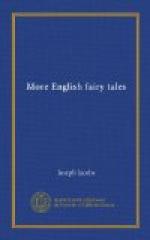Parallels.—Chambers, l.c., gave a variant with the title “The Red Bull o’ Norroway.” Kennedy, Legendary Fictions, p. 87, gives a variant with the title “The Brown Bear of Norway.” Mr. Stewart gave a Leitrim version, in which “Norroway” becomes “Orange,” in Folk-Lore for June, 1893, which Miss Peacock follows up with a Lincolnshire parallel (showing the same corruption of name) in the September number. A reference to the “Black Bull o’ Norroway” occurs in Sidney’s Arcadia, as also in the Complaynt of Scotland, 1548. The “sale of bed” incident at the end has been bibliographised by Miss Cox in her volume of variants of Cinderella, p. 481. It probably existed in one of the versions of Nix Nought Nothing (No. vii.).
Remarks.—The Black Bull is clearly a Beast who ultimately wins a Beauty. But the tale as is told is clearly not sufficiently motivated. Miss Peacock’s version renders it likely that a fuller account may yet be recovered in England.
XLIX. YALLERY BROWN
Source.—Mrs. Balfour’s “Legends of the Lincolnshire Fens,” in Folk-Lore, ii. It was told to Mrs. Balfour by a labourer, who professed to be the hero of the story, and related it in the first person. I have given him a name, and changed the narration into the oblique narration, and toned down the dialect.
Parallels.—“Tiddy Mun,” the hero of another of Mrs. Balfour’s legends (l.c., p. 151) was “none bigger ’n a three years old bairn,” and had no proper name.
Remarks.—One might almost suspect Mrs. Balfour of being the victim of a piece of invention on the part of her autobiographical informant. But the scrap of verse, especially in its original dialect, has such a folkish ring that it is probable he was only adapting a local legend to his own circumstances.
L. THE THREE FEATHERS
Source.—Collected by Mrs. Gomme from some hop-pickers near Deptford.
Parallels.—The beginning is a la Cupid and Psyche, on which Mr. Lang’s monograph in the Carabas series is the classic authority. The remainder is an Eastern tale, the peregrinations of which have been studied by Mr. Clouston in his Pop. Tales and Fictions, ii., 289, seq. The Wright’s Chaste Wife is the English fabliau on the subject. M. Bedier, in his recent work on Les Fabliaux, pp. 411-13, denies the Eastern origin of the fabliau, but in his Indiaphobia M. Bedier is capable de tout. In the Indian version the various messengers are sent by the king to test the chastity of a peerless wife of whom he has heard. The incident occurs in some versions of the “Battle of the Birds” story (Celtic Fairy Tales, No. xxiv.), and considering the wide spread of this in the British Isles, it was possibly from this source that it came to Deptford.




